Introduction
Integrating sewer camera technology into your landscaping projects can greatly improve efficiency and address potential issues with precision. By utilizing these cutting-edge devices, you can ensure that underground infrastructure problems are identified quickly, preventing costly disruptions later on. Companies like Liberty Landscape emphasize a "done right the first time" approach, aligning perfectly with the benefits of using sewer cameras for proactive problem-solving.
The landscaping industry's substantial worth underscores the impact these technologies can have on service quality and customer satisfaction. In this article, we will explore the top benefits of sewer camera rental and how it can enhance the maintenance and upkeep of your green spaces. We will also discuss cost-effective solutions, time-saving advantages, and the importance of accuracy, environmental impact reduction, and improved safety.
Additionally, we will provide practical steps to maximize efficiency with sewer camera rental, such as choosing the right equipment, training your team, optimizing inspection routes, utilizing advanced features, maintaining equipment regularly, avoiding common mistakes, and leveraging data analysis. By embracing these strategies, you can ensure the success of your landscaping projects while prioritizing quality craftsmanship and customer satisfaction.
Why Use Sewer Camera Rental for Efficiency
Integrating sewer camera technology into your landscaping projects in the Dallas-Fort Worth area can lead to a significant uptick in project efficiency. These cutting-edge devices allow for a meticulous examination of underground infrastructure, pinpointing potential issues with unerring accuracy. This ensures that any problems are identified quickly, allowing for immediate action to prevent costly and time-consuming disruptions later on.
Through the lens of companies like Liberty Landscape, which has expanded its reach across Missouri since 2018, the importance of precision and quality in landscaping work is evident. They emphasize a "done right the first time" approach, which aligns perfectly with the benefits of using sewer cameras to preemptively address underground issues.
Moreover, the landscaping industry's substantial $105.1 billion worth underscores the scale at which these technologies can have an impact. With over half a million individuals employed in landscaping across the United States, the adoption of such efficient tools could lead to widespread enhancement of service quality and customer satisfaction.
In the context of preventive maintenance versus reactive repairs, the use of sewer cameras embodies the proactive mindset. This is akin to the maintenance investment method discussed by experts like Ryan Watson of AQUALIS, which is designed to mitigate risks and spot early signs of system failure, ultimately protecting the asset—your landscaping project—from unforeseen complications.
Top Benefits of Sewer Camera Rental
Incorporating sewer camera rental into your landscaping projects in the Dallas-Fort Worth area offers key advantages that can make a significant difference in the maintenance and upkeep of your green spaces. A sewer camera is an invaluable tool for identifying potential issues before they escalate into costly repairs.
One of the primary benefits of using a sewer camera is the ability to conduct thorough inspections of underground pipes. This proactive approach aligns with the maintenance investment method, which prioritizes regular checks to catch the first signs of system failure, as highlighted by experts like Ryan Watson of AQUALIS during industry discussions. This method is decidedly more cost-effective than the run-to-fail method, which can lead to sudden and unexpected breakdowns, resulting in interruptions to your project and hefty repair bills.
Moreover, the insights gained from sewer camera inspections can prevent the kind of structural damage that, if overlooked, could compromise the integrity of your landscaping project. Similar to how a leaky roof can lead to water seepage and subsequent damage, a compromised sewer line can wreak havoc on the surrounding landscape, potentially causing soil erosion and damage to plants or paved areas.
The economic significance of the landscaping industry, worth an estimated $105.1 billion, underscores the importance of investing in tools and methods that safeguard assets and contribute to the sector's growth. With over half a million people employed in landscaping services across the United States in 2021, the industry not only impacts the economy but also reflects the value placed on maintaining and enhancing outdoor spaces.
Utilizing a sewer camera rental can be a strategic decision that not only prevents disruptions but also ensures the longevity and beauty of your landscaping projects. By embracing such technology, you're not only maintaining the aesthetic appeal of your projects but also protecting the substantial investment that property owners place in their landscape.
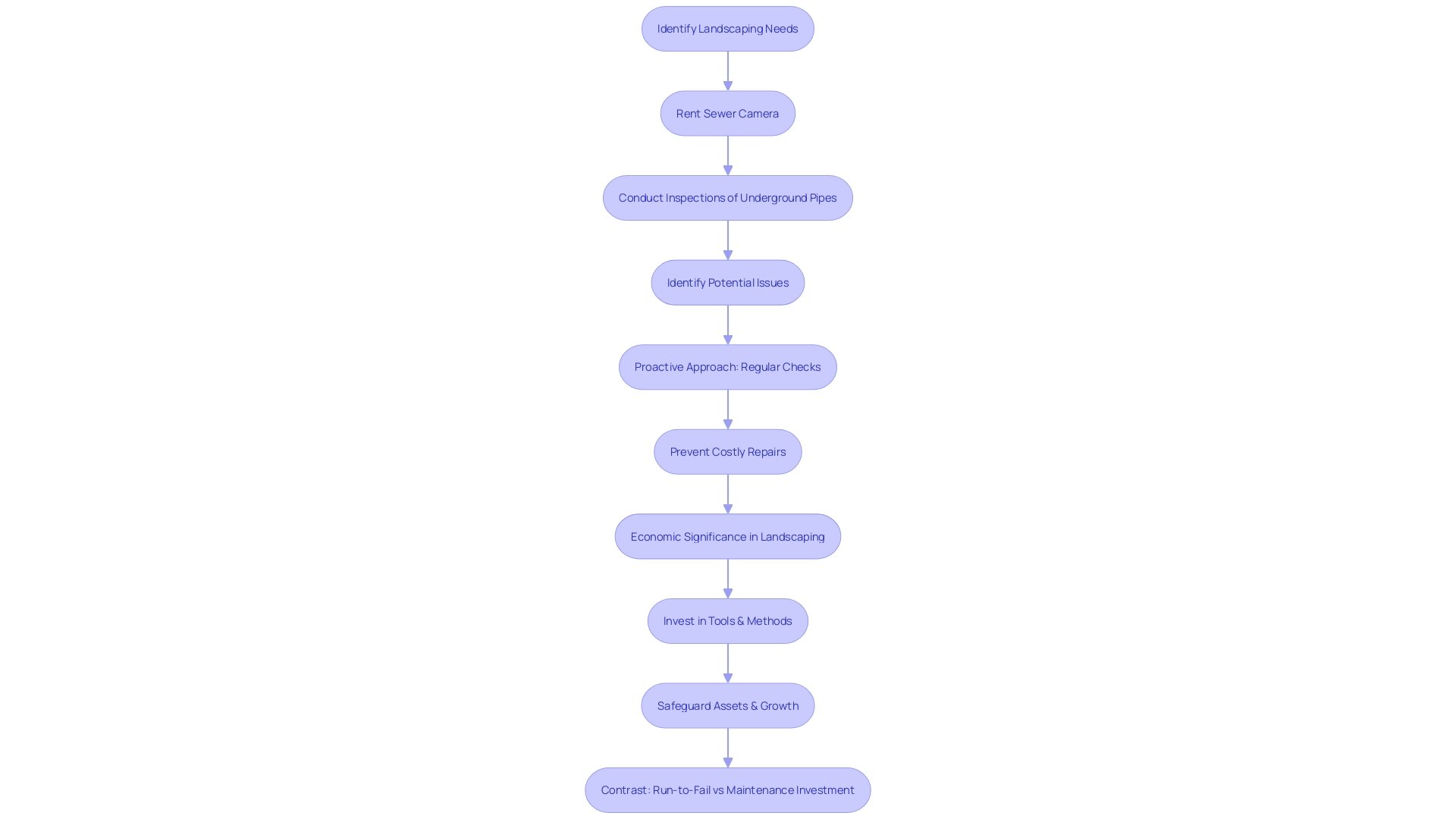
Cost-Effective Solution
Choosing to rent a sewer camera can be a savvy decision for those looking to manage their costs effectively. This option enables you to forgo the hefty initial investment of purchasing such specialized equipment outright. Furthermore, the burden of maintenance and potential repair costs, which can accumulate over time, are also sidestepped.
This is particularly useful in the context of complex urban infrastructures like those in Hamilton, Ontario, where advanced technology has proven essential in managing the city's elaborate water systems with high levels of non-revenue water (NRW). A pilot study in Hamilton led to the adoption of a full-scale, proactive leak detection program, which boasted an impressive 95.6% accuracy rate. This example underscores the potential benefits of renting high-quality, advanced equipment for specific, short-term projects.
As the world grapples with environmental challenges, such as litter and pollution impacting urban waterways, the need for efficient and effective solutions is clear. Renting equipment like sewer cameras aligns with the drive for innovative and sustainable practices in managing our resources and infrastructure. Notably, the importance of data in driving these solutions is highlighted by Mark Twain's poignant remark, "Data is like garbage.
You’d better know what you are going to do with it before you collect it. ", reinforcing the necessity of strategic planning in environmental management efforts.
Moreover, recent news about the development of air-powered devices, such as the computer that can signal problems with lifesaving compression machines by blowing a whistle, illustrates the ongoing innovation in technology that can be leveraged for various applications—including sewer inspection and maintenance. By renting equipment, you gain access to the latest technological advancements without the commitment and cost of ownership, allowing you to stay at the forefront of industry progress and environmental stewardship.
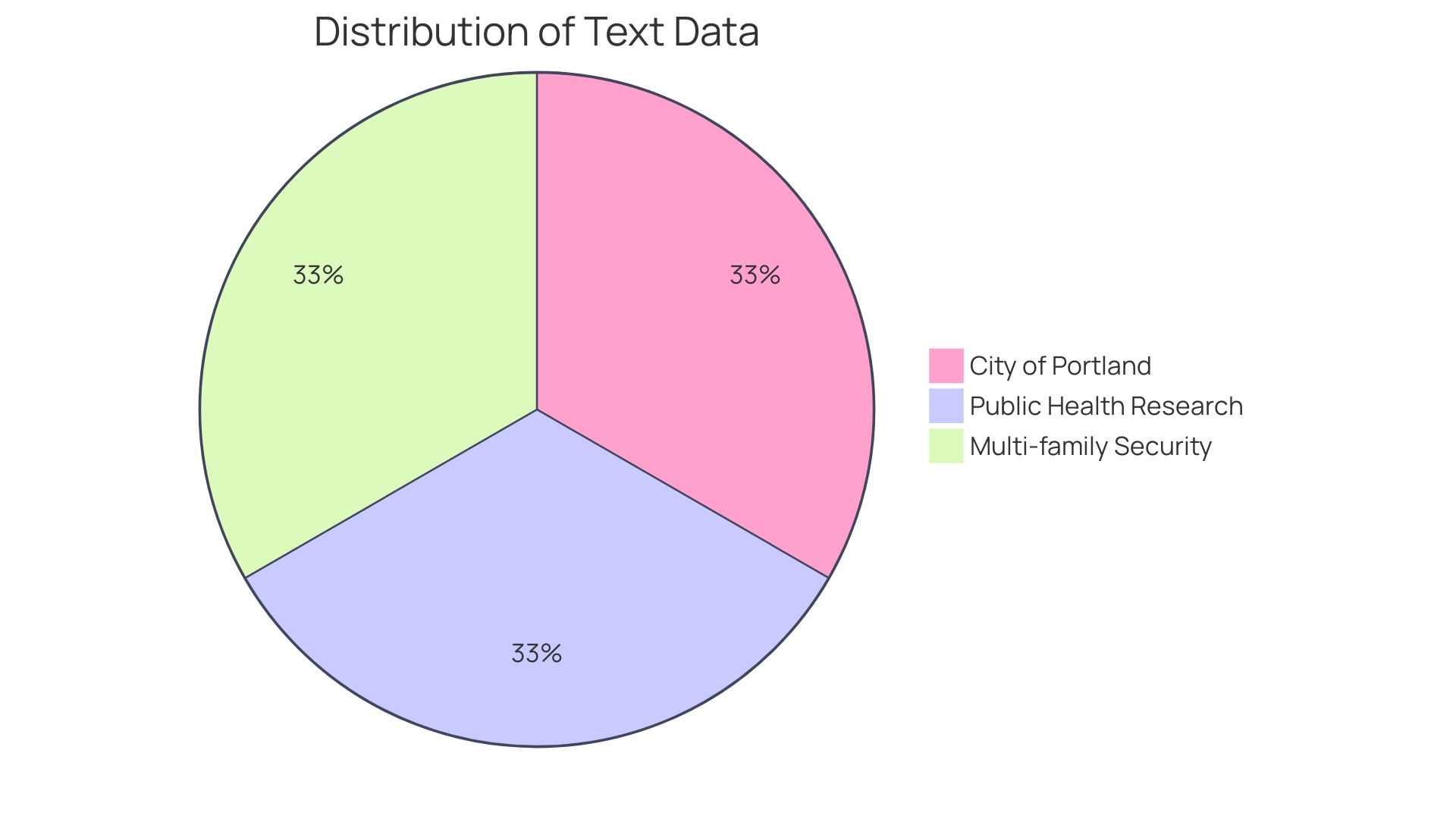
Time-Saving
Integrating cutting-edge technology into landscaping projects can streamline operations and enhance productivity, particularly when dealing with the intricate web of underground utilities. For instance, incorporating a sewer camera into your toolkit can revolutionize the way you approach subsurface inspections. Traditional methods, such as manual probing, are not just labor-intensive but also come with a high risk of inaccuracies and potential damage to existing infrastructure.
With a sewer camera, however, you can swiftly navigate through pipes to pinpoint blockages, cracks, or other issues without the need for extensive excavation work.
This approach is akin to the innovative use of cameras in applications like the Grime Guardian, which transforms mundane tasks like dishwashing into engaging activities through timely notifications and recognition. Similarly, Amazon Sidewalk leverages the power of connected devices to extend the reach of smart technologies, exemplifying how a network of cameras can facilitate efficient operations, even in complex environments such as outdoor landscaping. By harnessing such technological advancements, you not only save time but also ensure a higher level of precision in your maintenance and repair work, aligning with the ethos of quality craftsmanship and client-first models that companies like Liberty Landscape embody.
Furthermore, staying informed about industry trends and forecasts, as presented in publications like Glenigan's UK Construction Industry Forecast, equips you with the knowledge to anticipate and adapt to market shifts, ensuring your landscaping projects continue to thrive. The lawn care industry's substantial valuation, coupled with a robust workforce, underscores the significance of adopting efficient practices to maintain a competitive edge. By embracing modern technologies, you position yourself to deliver excellence, much like reliable pavement companies that prioritize customer satisfaction and skillful execution in every project.
As we move forward, the integration of such tech-centric solutions in landscaping projects is poised to become the norm, offering a blend of aesthetic appeal and practical functionality to meet the demands of discerning clients.
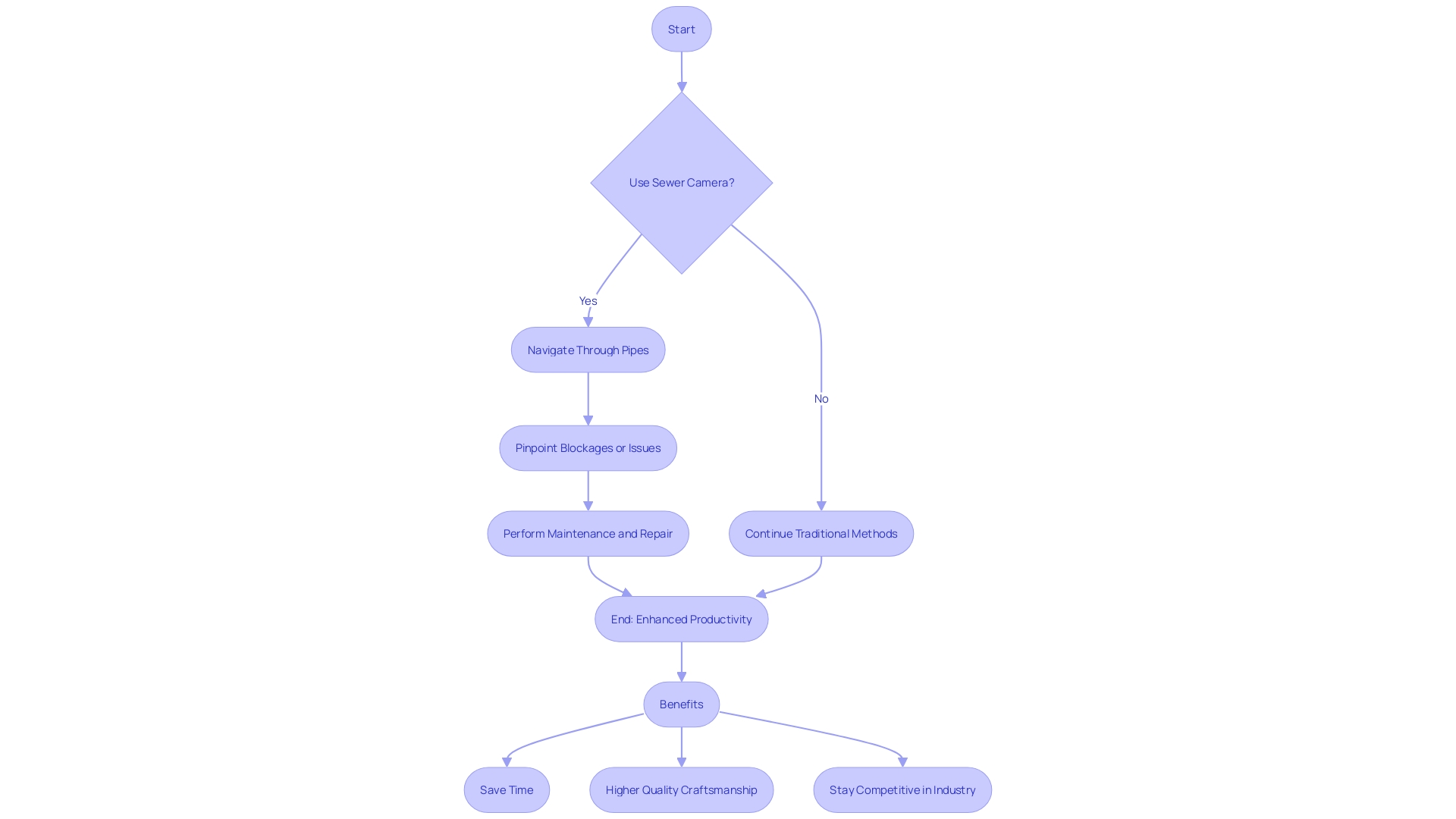
Enhanced Accuracy
Harnessing the power of high-tech sewer camera rentals can significantly boost the precision of underground pipeline inspections. This sophisticated equipment is designed to deliver crystal-clear visual data, enabling detailed analysis of pipelines to uncover even the most minute imperfections, such as fractures, leaks, or obstructions caused by roots. For instance, in Louisville, Kentucky, advanced robotic devices have been deployed to assess the condition of water mains, some of which are fully operational during the inspection, showcasing the non-intrusive and efficient capabilities of modern inspection technology.
Similarly, in Hamilton, Ontario, a proactive leak detection initiative leveraging cutting-edge methods achieved a remarkable 95.6% accuracy rate, underscoring the effectiveness of such technologies in maintaining critical infrastructure. By integrating these advanced inspection tools, stakeholders can enact informed maintenance strategies, ultimately safeguarding the integrity of vital underground systems.
Environmental Impact Reduction
Adopting sewer camera technology for landscape project assessments has become a pivotal practice for those who prioritize environmental stewardship. Unlike traditional methods, which often require significant ground disturbance, sewer cameras enable precise inspections with minimal intrusion. This approach aligns with the ethos of places like the Santa Lucia Preserve in California, where environmental integration is paramount, and methods that preserve the ecosystem are favored.
For example, in the quest to meet The Living Building Challenge, innovative and non-disruptive techniques are essential. Sewer camera rental not only aligns with such high environmental standards but also supports the maintenance investment method discussed by experts like Ryan Watson of AQUALIS, by helping to identify issues early, before they necessitate major interventions. By embracing this technology, landscape professionals can ensure the integrity of their work while upholding the delicate balance between development and nature conservation, a balance that firms like Ayers Saint Gross strive to maintain in their sustainability practices.
Improved Safety
In the realm of landscaping, the paramount concern is the well-being of those on-site. The advent of sewer camera rental is revolutionizing safety protocols, offering a high-tech alternative to the traditional, and often risky, method of manual inspection. These sophisticated devices allow for thorough examination of underground pipes and sewer lines without the need for workers to physically enter these potentially perilous areas.
Not only does this technology significantly diminish the likelihood of on-the-job accidents and injuries, it also circumvents the complications that arise from dealing with unstable terrain or confined spaces.
A case in point is the project undertaken by Metro Waterproofing late in 2022, which involved intricate waterproofing for a subterranean parking structure. The team navigated an array of obstacles, from chilly temperatures affecting material application to the challenge of waterlogged sandy soil that threatened the integrity of the waterproofing system. The utilization of advanced inspection technology, similar to sewer cameras, could have offered a safer and more efficient means to assess and respond to these conditions.
Statistics highlight the urgency of integrating safety innovations into construction practices. With an alarming frequency of workplace injuries and a staggering $163.9 billion in related costs in 2020 alone, the construction industry is in dire need of solutions that preempt human error—the cause behind 80% of workplace accidents. Tools like sewer cameras not only offer immediate safety benefits but also contribute to a culture of prevention and meticulous planning that can mitigate the financial and reputational repercussions of accidents.
Industry experts emphasize the critical nature of construction safety. As one quote succinctly puts it, "Construction safety is about protecting the well-being of the individuals who work tirelessly to build our homes, infrastructure, and cities. It’s about safeguarding lives, preventing injuries, and mitigating the financial and emotional toll of accidents."
The adoption of sewer camera rental is in alignment with these values, providing a tangible way to reduce risks and enhance the overall success of landscaping projects.
Steps to Maximize Efficiency with Sewer Camera Rental
Maximizing project value and ensuring quality are key to successful landscaping, and the right equipment rental can make a significant difference. To enhance the efficiency of your landscaping projects with sewer camera rental, begin by addressing any structural issues, such as plumbing, that might obstruct your progress. A comprehensive understanding of the project's layout, including any potential safety hazards, is crucial for a smooth operation.
Incorporating expert advice, like the insights from Ryan Watson of AQUALIS, helps in evaluating risks and identifying early signs of system failure. Taking a proactive approach rather than a run-to-fail method can prevent costly repairs and downtime. It's also important to understand the root causes of common issues in your backyard, such as incorrect planting depth, and address them to prevent structural damage or tripping hazards.
When plumbing problems arise, locating the issue is the first step. Using the correct tools, like plumbing snakes, can provide a solution for visible blockages, but remember to consult a professional when the issue is beyond your expertise. As stated by industry experts, missteps can lead to further damage and should be avoided.
The lawn care industry, with an annual worth of approximately $105.1 billion and employing over half a million people in the U.S., reflects the significance of landscaping services. With this in mind, investing in the right equipment and knowledge can lead to successful project outcomes, aligning with Liberty Landscape's commitment to craftsmanship and client-first models.
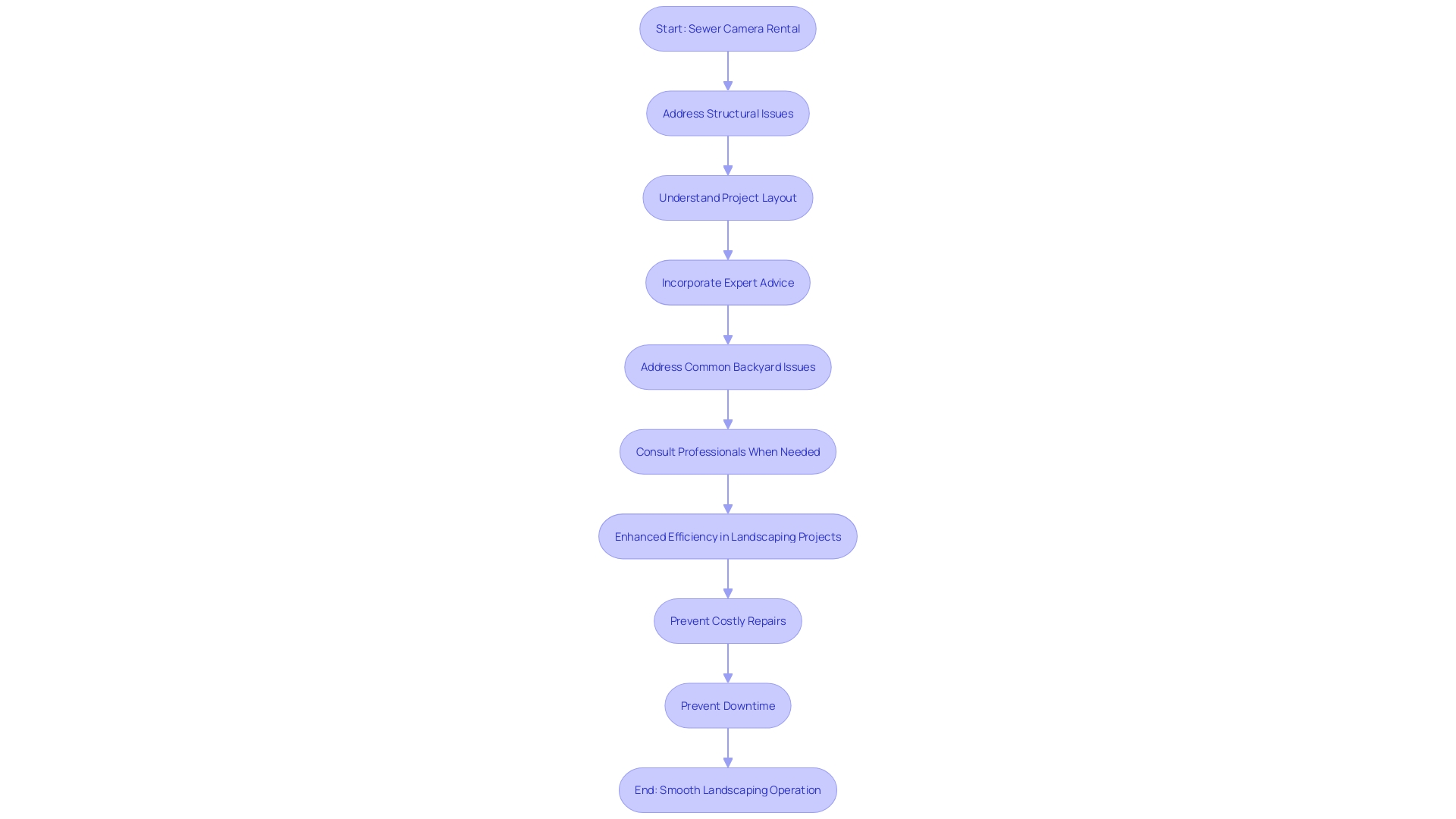
Choose the Right Equipment
Choosing the right sewer camera for your project is crucial for accuracy and efficiency. High-resolution cameras are essential to clearly identify obstructions, damages, or irregularities in sewer lines. A lengthy and durable cable is also important to navigate complex sewer systems without interruptions.
Furthermore, additional features such as LED lighting and self-leveling capabilities can provide better visibility and easier navigation through pipes. The experience of Metropolitan Council's Environmental Services division, where maintenance staff used a sewer camera to discover a lost diamond ring, underlines the importance of quality equipment in uncovering unexpected issues. Similarly, Boldyn Networks' emphasis on specialized solutions reflects the need for customized equipment to meet specific project demands.
Sewer camera inspections are not only necessary for maintenance but also for ensuring that replacements and repairs are carried out effectively, as stated by Greer Water Works, which prides itself on quality service. These insights, coupled with the growing lawn care industry, which boasts an economic impact of approximately $105.1 billion and employs over half a million people, illustrate the significance of investing in reliable sewer camera technology for maintenance and repair services within the industry.
Train Your Team
To ensure the smooth operation of sewer camera equipment during inspections, comprehensive training for your team is vital. They must become adept at using the controls and understanding the functions, as well as being able to quickly troubleshoot any issues that arise. This not only bolsters efficiency but also ensures the accuracy of the diagnostic results.
For instance, a compressed air auditor's visit to a mining facility highlighted the importance of understanding complex systems to identify savings in electricity consumption. Similarly, training helps in recognizing patterns and potential problems in equipment use, much like the auditor who discovered excessive air flow during non-production times. Proper training can prevent mishandling and promote proactive maintenance, comparable to the measures taken by utilities using drones for infrastructure inspections.
These drones, governed by FAA regulations, require operators to have specific certifications and maintain detailed logs, underscoring the significance of thorough training. Moreover, the use of drones highlights a shift towards advanced, efficient, and safer inspection processes, which can be paralleled by adopting thorough training practices for sewer camera operations. By investing in comprehensive training, your team can conduct inspections with the same level of precision and care as these technologically advanced methods, ensuring equipment is used to its full potential and inspections are carried out safely and effectively.
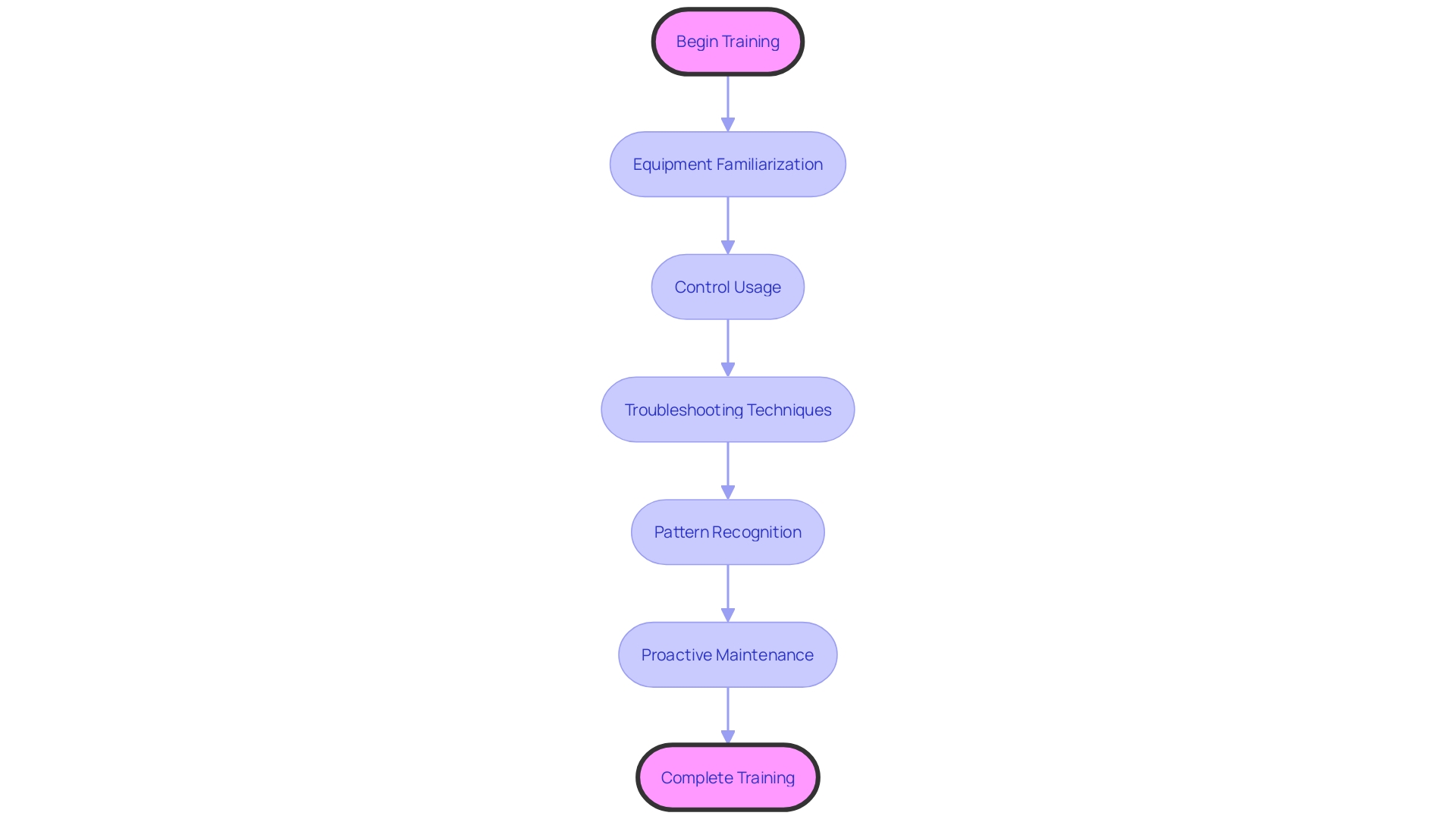
Optimize Inspection Routes
Embrace the power of strategic planning and machine learning to streamline your inspection workflows. Just like the innovative approach taken by United Airlines' Digital Technology team, using advanced techniques such as computer vision (CV) and natural language processing (NLP), you can benefit from automating tasks that traditionally required extensive manual effort. By adopting a similar mindset, you can optimize inspection routes, focusing on critical areas while minimizing redundant movements.
This targeted approach not only conserves valuable resources but also enhances the efficiency of inspection processes. Leverage the lessons learned from United's passport analysis model to refine your operation, making it more resilient, flexible, and cost-efficient. Harness the potential of technology to turn complex tasks into manageable, precise, and swift actions that drive your business forward with confidence and precision.
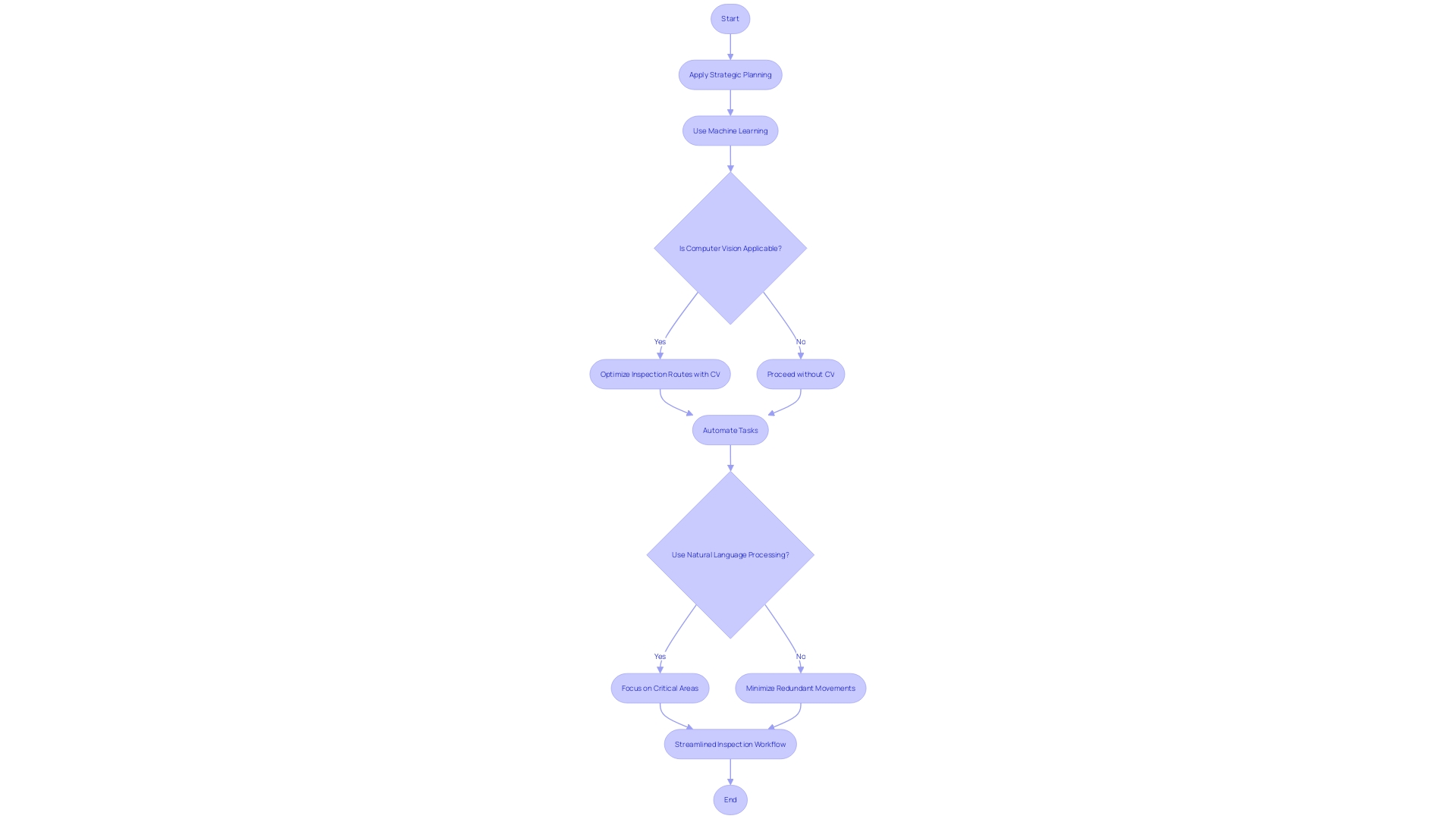
Utilize Advanced Features
Harnessing the power of advanced sewer camera features can significantly enhance the effectiveness of pipe inspections. For example, built-in locators can pinpoint the exact location of issues within the pipe network, which is especially valuable in complex systems like Hamilton, Ontario's intricate water distribution network, where proactive leak detection plays a crucial role in managing nonrevenue water.
Moreover, distance measuring capabilities offer precision in assessing the length of pipelines affected by obstructions or damages. This is similar to the technology utilized by the Louisville Water Company, where robotic devices traverse water mains, providing detailed inspections without the need for system shutdowns. Recording capabilities are equally important; they allow for the documentation of inspections, which can be reviewed for meticulous analysis, as seen in the use of swimming robots that capture images and send ultrasonic signals to assess pipe conditions.
These technological enhancements in sewer camera equipment are not just for large-scale operations. Even homeowners can benefit from understanding their plumbing systems better, as detailed in the comprehensive guide on kitchen sink drainage. By leveraging such high-tech features, professionals can ensure precise diagnostics, enabling them to address issues more effectively and maintain the integrity of the plumbing infrastructure.
Maintain Equipment Regularly
To maintain the efficiency and functionality of sewer camera equipment, it is essential to adhere to a systematic maintenance routine. The intricacies of such equipment demand attention to detail—cleaning according to the manufacturer's instructions, secure storage, and adherence to scheduled maintenance tasks are fundamental practices. Frequent inspections are necessary to identify components that may need replacement, such as cables and connectors, to prevent potential breakdowns and ensure that project workflows remain uninterrupted.
The importance of diligent maintenance is exemplified by Sulzer's comprehensive approach to managing complex equipment projects. By centralizing project management and executing maintenance and repairs across multiple systems, Sulzer was able to streamline processes and reduce costs for their clients. This underscores the value of a proactive, rather than reactive, maintenance strategy.
Similarly, in the compressed air audit case, the identification of excessive air consumption due to lax maintenance underscored the potential savings achievable through diligent system management.
Unexpected incidents, like the discovery of a diamond ring in a wastewater treatment plant, highlight the unforeseen challenges maintenance staff may encounter. Such stories not only emphasize the importance of routine checks and maintenance but also the need for agility and preparedness in responding to unusual occurrences.
By prioritizing maintenance, organizations can mitigate the risk of unplanned downtime, which is particularly costly in sectors that depend on the continuous operation of advanced technical systems. The implementation of preventive maintenance, guided by real-time data from sensors, can significantly enhance the availability and reliability of these systems.
In essence, regular maintenance not only preserves the condition of equipment but also contributes to the greater efficiency and cost-effectiveness of operations, aligning with the goal of optimizing equipment rental for landscaping projects in areas like the Dallas-Fort Worth region.
Common Mistakes to Avoid
Efficiently managing sewer camera rental demands awareness of potential pitfalls that can stall progress and inflate costs. For instance, the case of a large mining operation audited for air system efficiency revealed staggering usage patterns. Despite non-production periods, the system consumed over 10,000 cubic feet per minute, indicating a costly lack of optimization amounting to nearly $2 million annually in electricity.
Likewise, a sewer project's media coverage error, where a Tennessee water main repair image was used for Virginia sewer work, underscores the importance of precise details in project management.
Furthermore, Hamilton, Ontario's experience with an elaborate water system and substantial non revenue water (NRW) levels led them to a successful leak detection program, highlighting the value of proactive measures and advanced technologies in managing municipal systems.
A common inefficiency in project management is the unnecessary time spent on product and material pickup, which can be mitigated by scheduling deliveries. Also, tree root intrusion, a prevalent issue causing structural damage and tripping hazards, can be largely attributed to improper planting depth—a problem that, if addressed correctly, saves significant future maintenance.
It's recommended to consider the existing layout and infrastructure before making changes, as suggested by Bethany Adams of Bethany Adams Interiors. Replacing fixtures without altering underlying plumbing can be a cost-effective approach, minimizing potential damage to property and finances. Recognizing the early signs of system failure and choosing between the run-to-fail method and maintenance investment can further protect assets and ensure efficient operation.
Knowledge of plumbing systems, such as kitchen sink drainage, and maintenance tasks like replacing a toilet's wax ring, are essential for homeowners to prevent leaks and damage. With these insights, construction project managers can apply strategic planning, leverage technology, and make informed decisions to optimize equipment rental and maintain project efficiency.
Lack of Proper Training
Effective training in operating sewer camera equipment is not just a matter of efficiency; it's a vital component in ensuring the accuracy of inspections. Consider the experience of a compressed air auditor tasked with identifying improvements in a large mine. Despite the complexity of the site, the auditor's expertise allowed for the discovery of significant inefficiencies, leading to potential savings of nearly $2 million dollars in electricity costs per year.
Similarly, ICL, a multinational manufacturing and mining corporation, relies on the continuous manual monitoring of their industrial equipment due to the challenging environmental conditions, highlighting the importance of skilled on-site workers. In the wastewater treatment industry, drone technology is increasingly recognized for its ability to perform inspections safely and effectively, reducing the physical risk to workers. However, strict FAA regulations necessitate specialized training and certification for operators.
These examples underscore the critical nature of comprehensive training—not only to leverage technological advancements but also to mitigate risks and reduce costs associated with manual monitoring. Therefore, investing in thorough training for your team is not merely an investment in their professional development but a strategic move to safeguard the integrity of your operations.
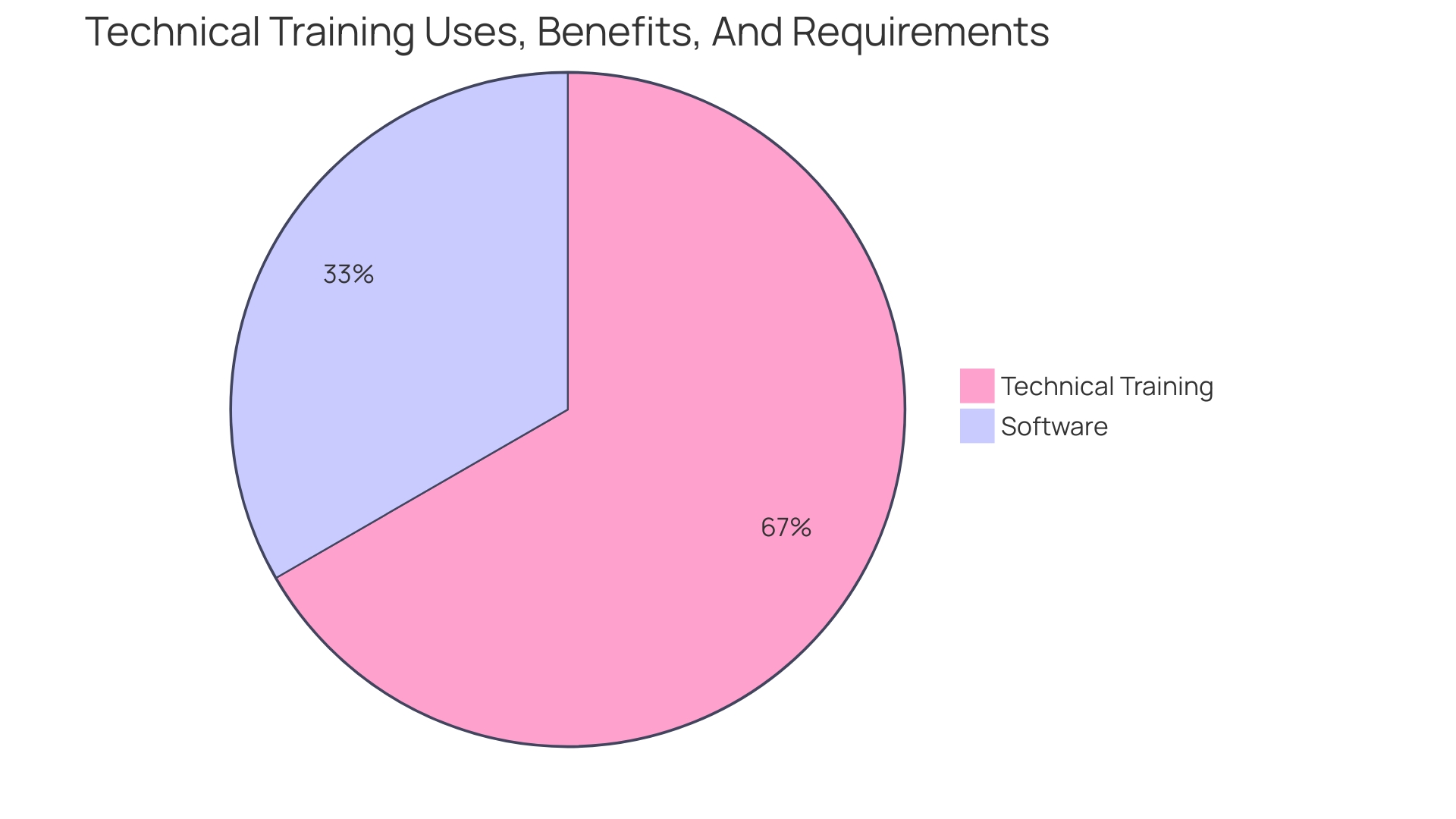
Neglecting Regular Maintenance
Ensuring the seamless operation of sewer camera equipment is crucial in managing the intricacies of wastewater treatment. A proactive approach to maintenance and service can prevent the costly and time-consuming breakdowns that can derail a project. For instance, the Environmental Services division of the Metropolitan Council uncovered a diamond ring in the Rogers Wastewater Treatment Plant, which could have been a maintenance issue had it not been for their vigilant servicing routine.
Similarly, understanding the risks and recognizing the early signs of system failure, as emphasized by Ryan Watson of AQUALIS, can protect your assets from unexpected disruptions. The power of preventative maintenance over the 'run-to-fail' method is clear—drone technology, for example, has revolutionized inspections and maintenance tasks, offering a safer and more cost-effective solution. This shift towards innovative maintenance strategies is essential for the stability and safety of critical infrastructures, such as substations, where any fault can have significant repercussions.
As per the power system statistics, manual inspections that rely on the physical condition of the substation and the subjective judgment of workers can lead to ineffective harm prevention. Adopting advanced methodologies can ensure not only the longevity of equipment but also the security and efficiency of the entire operation.
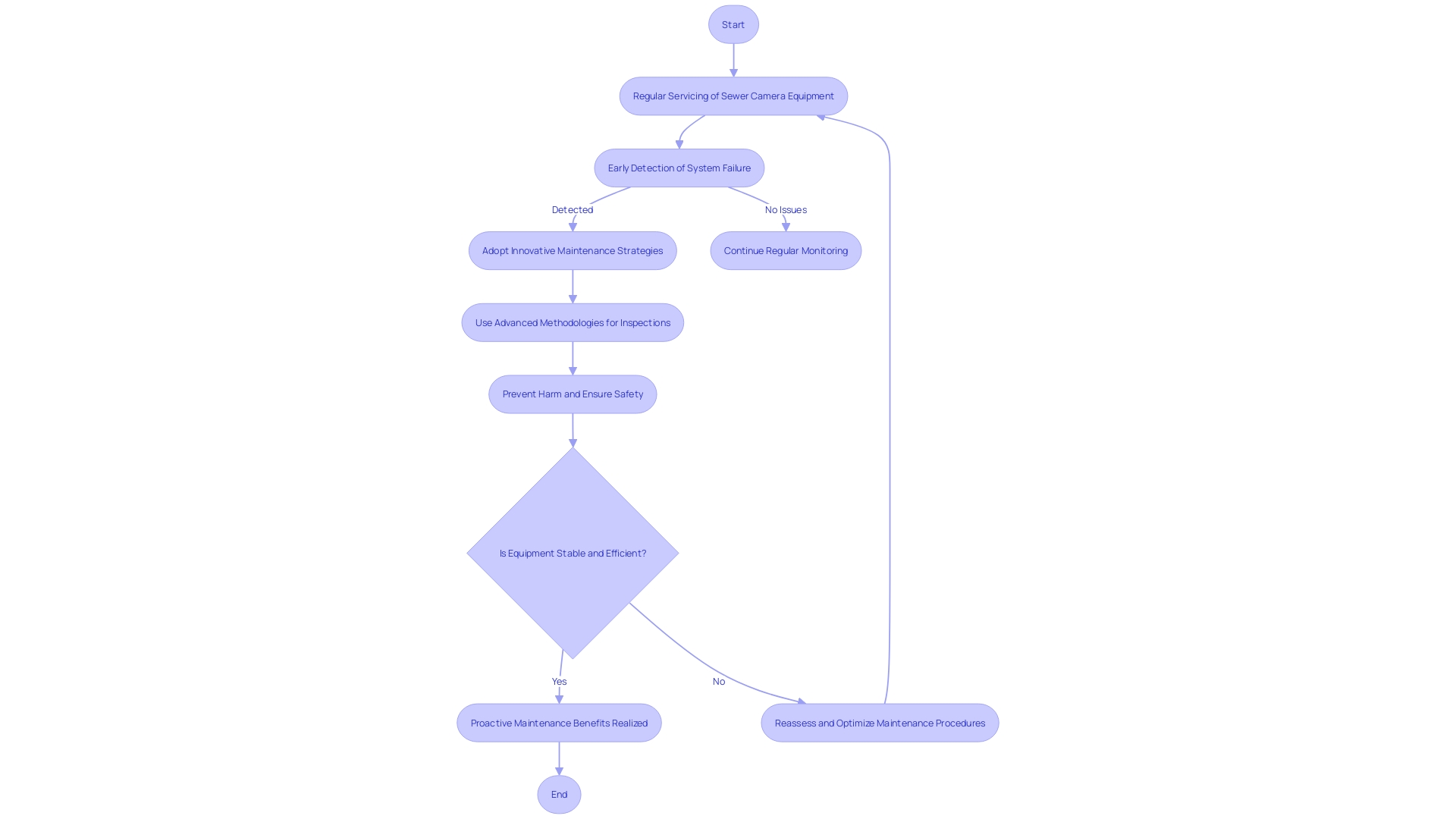
Skipping Documentation
Ensuring the meticulous recording of inspection outcomes is a cornerstone of effective management and maintenance within the realm of construction and engineering projects. It is not only a matter of regulatory compliance, as evidenced by the Federal Aviation Administration's (FAA) stringent Part 107 regulations for commercial drone operators but also a key to maintaining the integrity and safety of infrastructure over time.
As these regulations necessitate the keeping of detailed flight records and maintenance logs, they underscore the importance of thorough documentation practices. Similarly, the Clear (Comparable, Legible, Actionable, and Robust) Documentation Framework reinforces the necessity for consistency in the process, content, and presentation of records. This framework is particularly relevant in the context of complex technological systems, where the potential for misinterpretation of data can have far-reaching consequences.
Consistent with the insights gained from interviews with executive communication experts, the integration of AI into corporate communication requires a balance between optimizing and stabilizing documentation structures. In a similar vein, utilities are increasingly relying on drone technology to safely and efficiently conduct inspections and maintenance. The advanced capabilities of these drones, such as high-resolution imaging and autonomous navigation, deliver precise and actionable data, which, when properly documented, serve as an invaluable asset for future decision-making.
The Norges Bank Investment Fund's emphasis on AI governance and policy underscores the growing recognition of the importance of responsible technology integration across industries. By adopting AI to streamline documentation and improve operational outcomes, organizations are not only enhancing efficiency but also positioning themselves to better navigate the evolving regulatory landscape and societal expectations.
It's clear, then, that rigorous documentation is not just a matter of routine but a strategic imperative. By adopting a comprehensive documentation strategy that aligns with frameworks like Clear and adheres to regulatory requirements, organizations can ensure clarity, comparability, and accountability, ultimately safeguarding the integrity and longevity of their infrastructure and technological systems.
Not Utilizing Data Analysis
Harnessing the power of data analysis can significantly enhance the maintenance and operational efficiency of sewer systems. By implementing a strategy similar to that used by ICL, a multinational corporation facing harsh conditions that make remote sensor monitoring challenging, you can extract valuable insights from sewer camera inspections. Just as ICL's workers frequently review camera footage to assess equipment status, your team can analyze sewer inspection data to recognize patterns that indicate potential blockages or structural issues.
Innovative collaborations, such as the one between the University of Sheffield, Yorkshire Water, and Siemens, demonstrate the importance of transitioning to automated systems for analyzing large quantities of sensor data. Their 'Pollution Incident Reduction Plan' aims to diminish pollution incidents by 50% by 2025. Implementing a similar automated analysis of sewer inspection data can lead to more sustainable practices, helping to preemptively address blockages and reduce the risk of river pollution.
Greg Pada from Aveva highlights the benefits of Data-Centric Engineering, which can cut data extraction costs by up to 80%. This approach ensures data consistency and facilitates better operational decisions. By adopting a Data-Centric Engineering mindset, you can streamline project workflows from inception to operation, ultimately reducing the need for manual data handling.
In the realm of water management, understanding water flow is crucial. Smart water networks equipped with real-time sensors can detect leaks and unusual usage patterns, prompting timely interventions. As predictive modeling technologies, like those developed by BlueConduit, enable water utilities to forecast system failures and prioritize maintenance, integrating similar technologies in sewer system management can offer foresight into infrastructure issues, guiding preventative actions before they escalate.
The transformative impact of data in tackling complex public issues is evident. By choosing the right technology, informed by the diverse needs and goals of stakeholders, you can optimize public problem-solving. Recognizing the potential of such data-driven approaches, it's imperative to analyze the information from sewer camera inspections to enable informed decision-making and to implement effective preventive measures for your sewer systems.
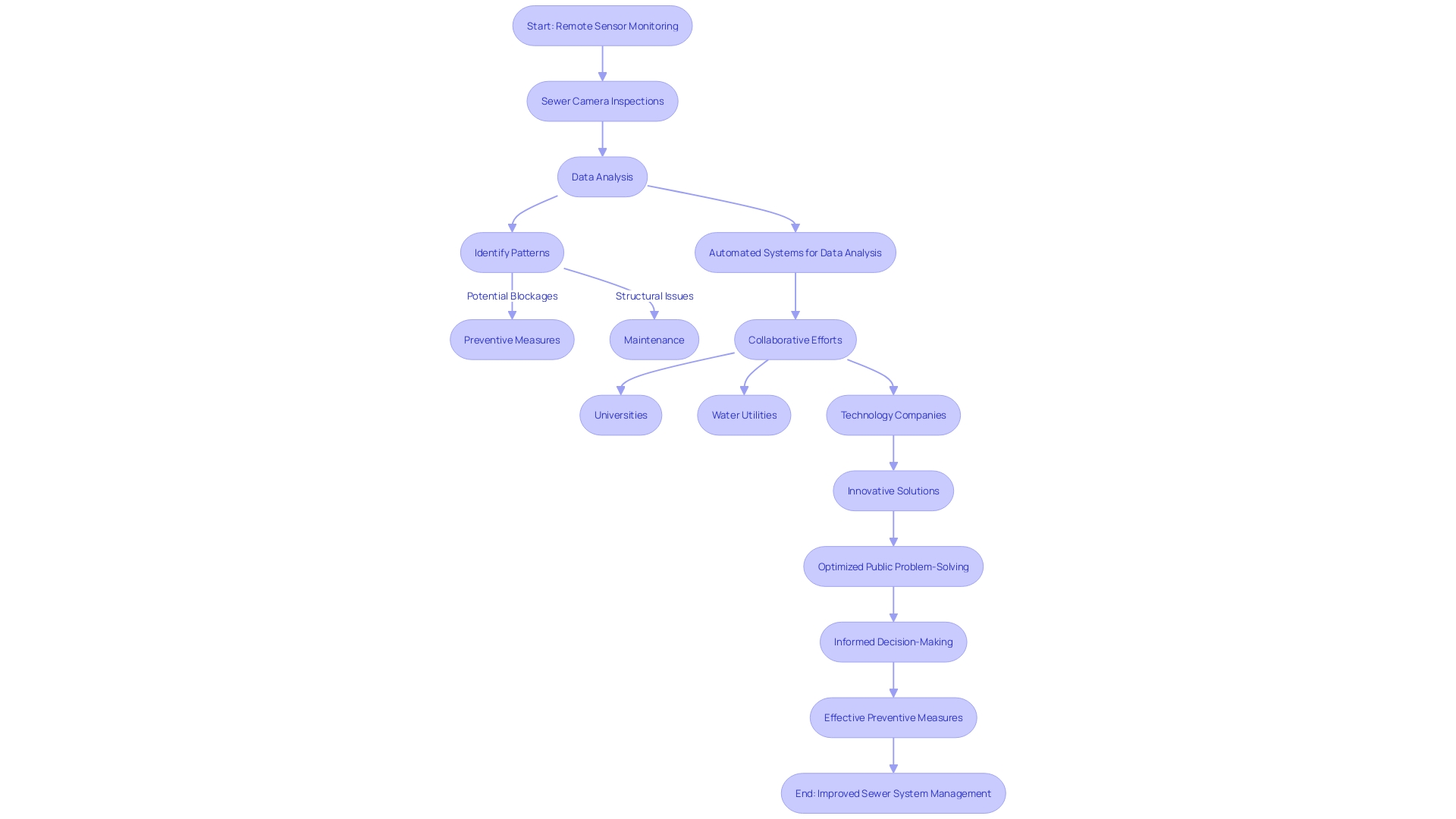
Conclusion
In conclusion, integrating sewer camera technology into landscaping projects offers numerous benefits. It improves efficiency by quickly identifying underground infrastructure problems and preventing costly disruptions. Thorough inspections of underground pipes ensure early detection of issues, protecting the integrity of landscaping projects.
Renting sewer cameras is a cost-effective solution that provides access to advanced technology without the commitment of ownership. The use of sewer cameras saves time by streamlining operations and enhancing productivity. It also enhances accuracy in underground pipeline inspections, allowing for informed maintenance strategies.
Adopting sewer camera technology aligns with environmental stewardship by minimizing ground disturbance. It revolutionizes safety protocols by eliminating the need for workers to enter hazardous areas. To maximize efficiency, it is important to choose the right equipment, train the team, optimize inspection routes, utilize advanced features, maintain equipment regularly, avoid common mistakes, and leverage data analysis.
By embracing these strategies, you can ensure the success of your landscaping projects while prioritizing quality craftsmanship and customer satisfaction.




